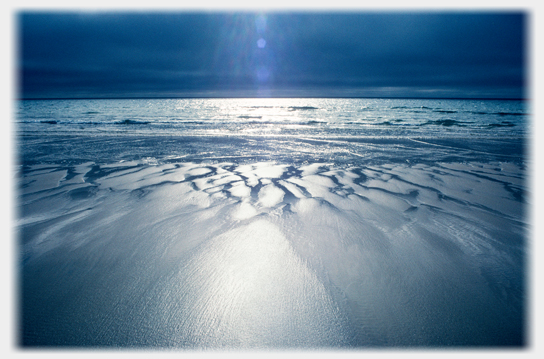
|
Horizons - Explanations
The curve of the horizon in the picture is, maybe sadly, only due to the distortions of the camera lens. Far from being false that the world in which we live is flat, it is demonstrably the case that it is so. The far horizon on the sea, lens distortions aside, is to our eyes straight, level and horizontal, the latter is hardly surprising as the two words come from the same source. Some time ago the Greeks had worked out that it was probably the case that the world was spherical, but they promptly forgot the idea.
Part of the attraction of sitting by the sea is staring out across the water at the horizon. What we see is a flat expanse, and 'it stands to reason' that it is flat or the water would drain away. For our normal experience, whether we look at a scene such as the one above from sea level, or survey the sweep of the ocean from a cliff top, we are presented with flat water. So for our ordinary purposes it is perfectly sensible to claim the world is flat.
Those are our observations. But we spend much of our lives not observing what is in front of us, but rather constructing worlds of ideas. And most of us share the idea that the world is not flat, and that the horizon, if seen from a very different perspective, would not appear as a straight line. The belief that the world was round came again in Europe before anyone had circumnavigated the globe or had had the opportunity of seeing its curvature from far away. Settled happily in our space-craft above the atmosphere we would feel vindicated in our belief, and to that viewpoint the notion of the curve would be appropriate.
Fundamental to our mental constructions is this process in which we have ideas about that which we cannot observe, and these in turn help us undertake observation, and so in turn fuel our ideas. Vital amongst that which cannot be observed is the future. It has to be continuously constructed as a set of ideas, a kind of model, which we then use to guide our actions, which in turn improve our predictions: our models. This is a sophisticated version of a feedback loop, and lies at the heart of consciousness itself.
The history of the flat world illustrates well the way our understandings work. Our explanations are not disembodied free floating concepts that have no location and no interconnections. Explanatory concepts are relative, targeted, rooted and purposeful devices and are key elements in consciousness making it possible to build the models which predict coming events, predictions which let us operate successfully as part of a given and specific environment; the one in which we find ourselves. That is the job of the models, the very job of consciousness, and it seems to be a job well done. Like most of our complex scientific understandings, the concept of the curvature of the earth is not designed for the use of our consciousness operating in our locale.
So the world is flat, and the world is round. It is flat for us here and now, and it is round in theory and, if we take up a very different view point,2 we can also see it as round. Neither hypothesising that the world is round, nor seeing it from a space craft as round, stop it being flat for our other purposes. By the same token, the fact that sub-atomic particles do not act in accord with Newtonian physics does not make the older physics false. It renders it relative.
References
- Gray, Jeffrey (2005) 'Consciousness: Creeping up on the Hard Problem' OUP.
- Nagel, Thomas (1986) 'The View from nowhere' OUP.
25th January 2015 ~ 21st July 2015